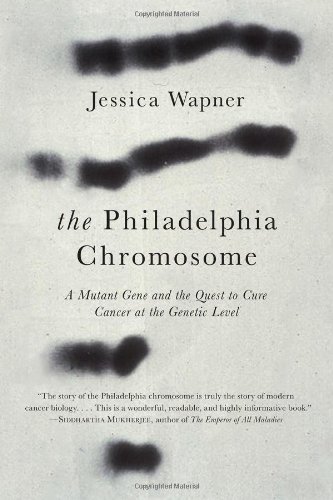
The Philadelphia Chromosome
A Genetic Mystery, a Lethal Cancer, and the Improbable Invention of a Life-Saving Treatment
یک معمای ژنتیکی، یک سرطان مرگبار، و اختراع احتمالی درمان نجات زندگی
فرمت کتاب
ebook
تاریخ انتشار
2014
نویسنده
Robert A. Weinbergناشر
Workman Publishingشابک
9781615191659
کتاب های مرتبط
- اطلاعات
- نقد و بررسی
- دیدگاه کاربران
نقد و بررسی

February 11, 2013
In this meticulously detailed chronicle, science writer Wapner recaps the remarkable development of Gleevec, a cutting-edge drug capable of beating the typically fatal cancer of white blood cells known as chronic myeloid leukemia (CML). But the story of Gleevec’s progress also illuminates how a “minute chromosome”—discovered in Philadelphia in 1959—led scientists on a journey to the genetic roots of cancer and “the modern era of personalized medicine.” Gleevec’s triumph—a 2012 study conducted of patients who had taken the drug 10 years ago showed a 68% survival rate—ultimately overcame the daunting unwillingness of Big Pharma and oncologists to accept a lab-synthesized “molecularly targeted medicine.” “In eighteen years,” Wapner writes, “a vision had been wrestled into reality.” Her gracefully written history skillfully combines both the science and humanity of this fascinating search for a cure for CML, including the heartbreaks of Gleevec-pioneering M.D. Brian Druker, thwarted efforts to get the drug into trials, jealousies between scientists, the love story of a reporter and Druker, and the compelling accounts of the patients themselves, who bravely tested the drug and ultimately reclaimed their lives. 8-page photo insert. Agent: Russell Galen, Scovil Galen Ghosh Literary Agency.

May 15, 2013
Freelance science writer Wapner has created a well-rounded work about the discovery of the Philadelphia chromosome, the causes of chronic myeloid leukemia (CML), and the development of the drug Gleevec to treat CML. Wapner does an excellent job of describing the many stages of basic, nonhuman, nonclinical research needed (some of which at first seemed to have no connection with the disease) that led to the knowledge necessary to treat CML. The book also illuminates the process of drug development and the tug of war between caution about side effects and the desire to cure cancer. The story also calls into question regulations that inhibit some industry/academic collaborations. VERDICT A refreshingly balanced view of the topic compared to the one-sided optimism found in Daniel Vasella and Robert Slater's Magic Cancer Bullet (2003). An excellent book for those who want to learn more about how medical discoveries are made and those interested in recent medical history, as well as those whose lives are affected by CML.--Margaret Henderson, Midlothian, VA
Copyright 2013 Library Journal, LLC Used with permission.

























دیدگاه کاربران